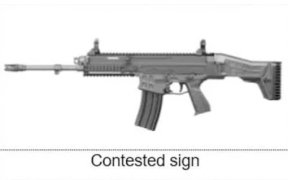Good for them we say…
WTR
The board confirmed that a figurative mark representing a rifle, covering goods and services associated with virtual firearms and focused on the virtual environment, lacked any distinctive character.
EUIPO The shape of a rifle is found not distinctive for virtual firearms
13/09/2023, R 275/2023-4, TVAR VIRTUÁLNÍ ST?ELNÉ ZBRAN? (fig.)
Non-distinctive – Shape of virtual goods – Relevant consumer – Decision confirmed – Case remitted to the examiner for examination of the acquired distinctiveness claim
The Board of Appeal (BoA) upholds the examiner’s decision to refuse registration of the figurative mark depicting an assault rifle for goods and services in the form of virtual firearms or online entertainment, sporting or cultural services aimed at virtual firearms, in Classes 9, 35 and 41 due to lack of distinctive character within the meaning of Article 7(1)(b) EUTMR. The BoA agrees with the examiner that the contested mark does not deviate in any fundamental way from the usual representation of the weapon, and therefore, merely informs the public of the nature of the goods and services at issue.
Importantly, the BoA highlights that unlike the process of purchasing a genuine firearm, where conditions such as age and other factors must be met, the purchase of virtual goods is subject to more accessible conditions. Consequently, the consumer base is much wider and whilst it cannot be excluded that within the relevant public there will be professionals with a knowledge of (virtual) firearms, consumers who possess a lower level of attention/expertise will also be included in that group. Therefore, the examiner was correct in holding that the level of attention of the relevant consumer is average to high.
The BoA also points out that the word elements (‘CZ BREN 2’) within the application are negligible and therefore are not sufficient to influence the absence of distinctiveness in its figurative elements. Furthermore, the BoA reiterates that design and trade mark are two distinct types of industrial property rights governed by different laws and having different criteria or conditions for registration. Therefore, the existing Community design has no direct effect on the distinctive character of the trade mark application in question.
Consequently, the BoA remits the case to the examiner for evaluation of the acquired distinctiveness claim under Article 7(3) EUTMR.




